The first time I ventured into Erewhon, I was 19 years old, new to LA, and with a friend easily swayed by wellness buzzwords. I was also enthralled by the color-coordinated aisles and the marvelous ingredients in the products, yet I remember feeling no desire to purchase anything. $10 for a bottle of almond milk? $21 for a small jar of vegan pesto? What is IN there? Almonds grown with Erewhon’s $26 gallon of water? Basil from an Italian grandma’s backyard?
Erewhon is a tourist attraction or source of comedy to many and an actual grocery store to a select few: people who can afford it, people who aspire to live like the rich and famous (but probably shouldn’t), and celebrities who are either trying to be seen or trying not to be seen (the distinction is blurry). To be a regular at Erewhon is to be assimilated to the unfairly stereotyped version of LA, the version teeming with matching sets and post-Equinox smoothies stuffed with superfoods. (Would recommend clicking that link for a funny video.)

The prices of products from common supermarket brands are marked up by 1 to 4 dollars, possibly to compensate for how many employees stand in the aisles just to smile at you and maintain an aesthetically pleasing display. Speaking of the aisles, they’re only 4 feet wide, designed with utter disregard for claustrophobics and extra attention to those looking for their life partner in a grocery store. The aisles are so narrow that they inevitably lead to awkward chuckles and soft-spoken apologies while squeezing past people who may become your friends because you know what they say…friends who eat the same almond butter stay together. Celebrity names adorn the tonic bar menu and the next thing you know, you’ve seen too many videos of the same Hailey Bieber (the TikTok crowd obviously refers to it as the Selena Gomez smoothie) strawberry glaze skin smoothie…with sea moss gel and hyaluronic acid. The classics! It’s impossible to eye the colorful produce at Erewhon without daydreaming about what my kitchen could look like if I shopped there.
While walking through Erewhon on a Saturday felt like I was at a party, at the end of the day, it’s still a grocery store strategically designed to convince you to buy things you may not need. To be fair, most supermarkets do exactly that; positioning Twix bars and gossip magazines by the checkout counter is a solid example. What distinguishes Erewhon is its focus on health and wellness – taken together with the exorbitant prices, Erewhon perpetuates the false idea that wellness is for the elite. And while it’s great that the vegan and gluten-free items are priced similarly to non-vegan alternatives (rather than being more expensive, as they often are), the abundance of specialty items at Erewhon relative to other grocery stores highlights the connection between veganism and individual health without drawing a similar degree of attention to other dimensions of veganism. It may also exacerbate the common misconception that plant-based eating is expensive and inaccessible.
Although Erewhon portrays the act of consumption as this sacred, community-oriented affair, it’s a facade in some respects. The vegetables may be straight from a local farm, but which local farm? Where exactly is the farm? Which practices do they use? These are questions you may be able to ask a farmer at the farmers’ market, but not at Erewhon. Erewhon highlights the purity of its products and where ingredients are sourced from without really telling you where they are sourced from. Maybe that’s where the name comes from? Erewhon, an anagram of “Nowhere,” is an insular escape from reality.
In the aisles, I encountered customers intently reading labels before making purchases as well as people reading labels to poke jokes about the buzzwords and prices, clarifying the division between types of shoppers. More remarkably, Erewhon is a luxury health food store in a city with vast income inequality, which can feel off-putting. When Erewhon opened in Silver Lake, LA Magazine underscored the contrast between Erewhon and the neighborhood it infiltrated – a neighborhood with “signs touting free ‘Grab & Go’ meals [on] the fence of the junior high” and a “homeless encampment…underneath an overpass” within a mile of the store. Erewhon’s emphasis on community and health while presenting an inaccessible image of wellness detracts from a collective responsibility for community health, further cementing divisions between social classes.
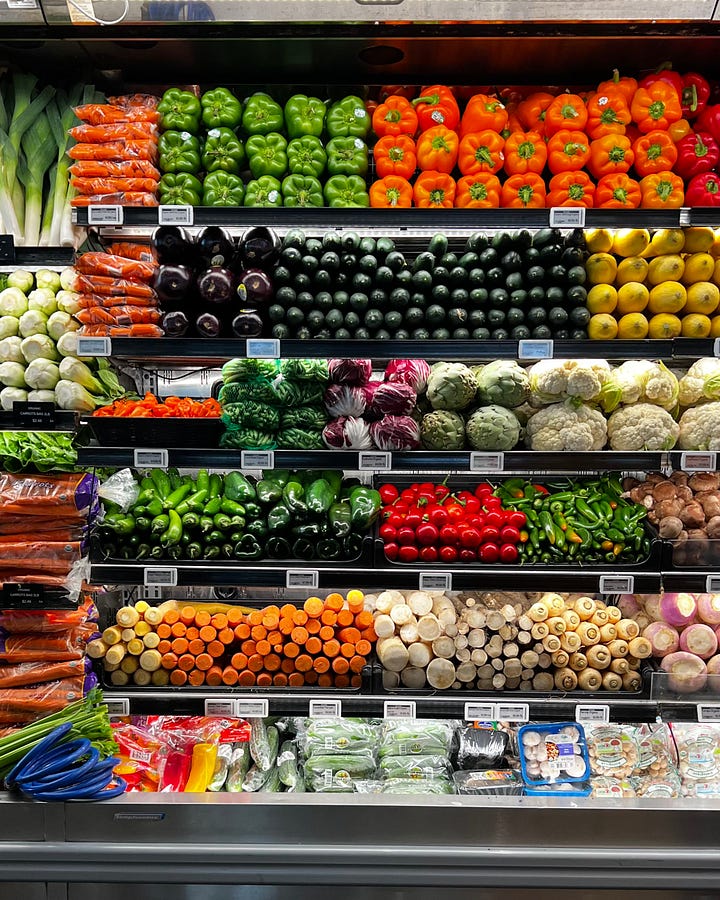

People love making fun of Erewhon. I love making fun of Erewhon. It’s not all bad though. Just a few weeks ago, I was under the impression that Erewhon was nothing more than a supermarket perpetuating the idea that wellness and self-improvement could be bought. But before my recent visit, I read this piece by Isabel Ling for Mold Magazine, which discussed Erewhon’s history. When Aveline and Michio Kushi opened their first store in Boston in 1966, they believed in the power of inciting political change through focusing on what people ate, and thus, they devoted themselves to promoting a macrobiotic diet before wellness was trendy.
“In order to get to the root of what was causing human beings to be aggressive, they turned to the internal factors — more specifically, what goes into your mouth. They understood that food had the power to harmonize people with their environments…At the center of these efforts were personal relationships with farmers and a familiarity with the land that was supplying Erewhon’s shelves.”
The Kushis had a radical vision that diverged from the way food was being sold in a quickly industrializing America. They partnered with “retailers, growers, and restaurants to form Organic Merchants,” a group that worked on creating standards for organic food, which gave rise to today’s organic movement. While mainstream wellness is often criticized for promoting Eurocentric ideas of health and the Erewhon of today often feeds into these Eurocentric narratives, that’s not how things began. Erewhon has long introduced products like miso and tofu to Western markets. Of course, the conversation grows complicated when “superfoods” from indigenous cultures become commodified and associated with luxury. Still, Erewhon exposes its clientele to small businesses that are just beginning to gain a foothold in the market. Erewhon makes some good things (fair wages, availability of plant-based alternatives, etc.) cool, so it’s difficult to completely bash what it stands for.
As I read Ling’s article, I wondered how this history could get so lost amid what Erewhon symbolizes today. It’s not necessarily a bad thing for products to be priced higher than the average supermarket if the prices are still somewhat reasonable and indicate fair wages for the people involved in production, but it is a bad thing when the story behind the price gets tangled in aspirational, shiny narratives connecting wealth to wellness.
In an NY Times interview, vice president of Erewhon Jason Widener said, “I don’t know if it’s cool any more these days to have a Bud Light jumping off a cliff, you know? It’s cool to have a green juice in your hand and jump off a cliff.”
If I ever have a green juice in my hand while jumping off a cliff I hope someone in my life is sensible enough to demand I put the juice down. That’s like dumping 20 bucks in the ocean!!!
Observations From the Field
Erewhon is ridiculous, but that didn’t stop me from having a lot of fun perusing the aisles, analyzing unfamiliar products, and eavesdropping on conversations. I’ve stepped in and out of Erewhon at least 3 times, usually just because I was in the area. This time, I decided to give Erewhon’s hot bar a chance after hearing people rave about the food. After a surface-level Reddit search, I identified that a few of the most popular items were the buffalo cauliflower, Japanese sweet potatoes, and kale white bean salad.

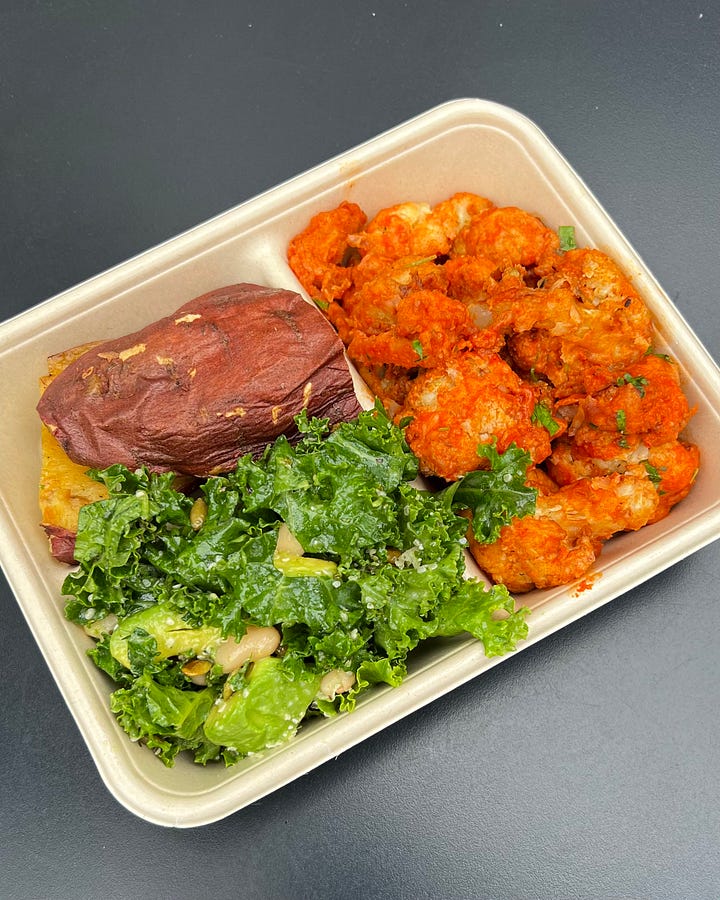
As an inexperienced Erewhoner, I didn’t realize that they weigh your food before attaching a price to it. The lady made eye contact with me before adding another sweet potato, as if to confirm whether it was ok to add another. Thinking that the $20 combo would be $20 no matter the quantity, I eagerly nodded. Bang for my buck, baby! I was wrong. Still, for $27 I received enough food for a solid meal. If it really was as good as a good restaurant, I could live with that. But it was not. The buffalo cauliflower, the item that people lauded the most, was too tart and soggy. The Japanese sweet potatoes were good, but aren’t Japanese sweet potatoes always good? I liked the kale white bean salad; no notes.
Besides the hot bar, I had a matcha latte with oat milk. Erewhon has a more expansive selection of plant-based milks than most coffee shops, which was nice. It was $6.25, which is quite standard for matcha in LA. The matcha itself was just as mediocre as most of the matcha I’ve had recently, so I wasn’t disappointed.
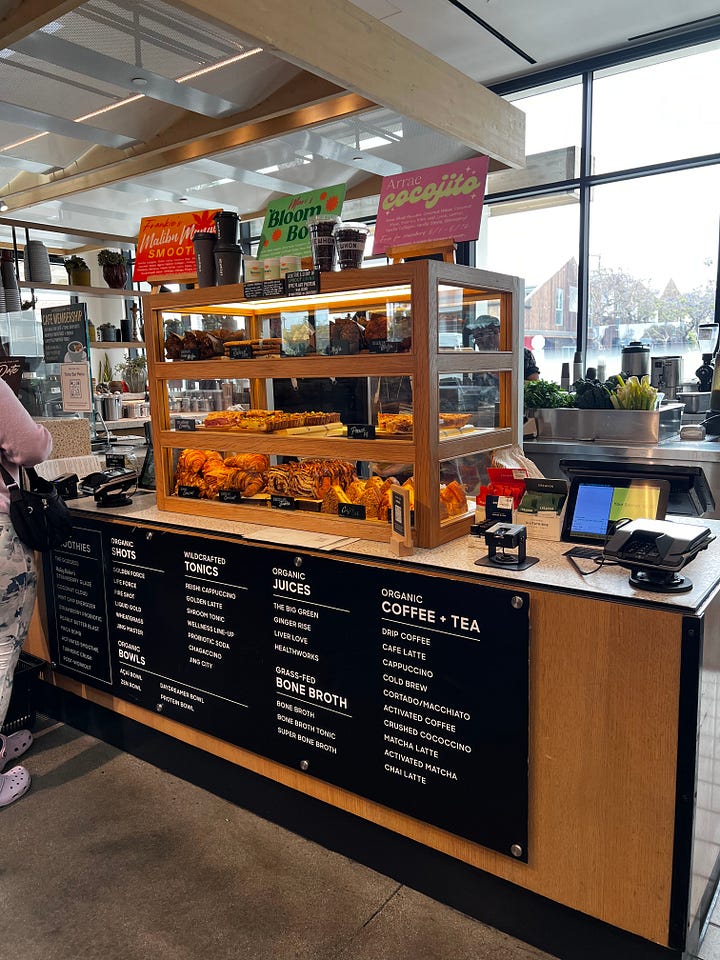

Now for the fun part! Notes from the museum. Here are some things I saw that compelled me to take a picture:
Plant-based milk specifically for kids, with seaweed, bananas, amla, and monk fruit extract.
Matcha chai with lion’s mane, cordyceps, chaga, and reishi - $52
Almond butter (11 oz) - $18
Pumpkin seed tofu
The soup display. So basically $15 for blended broccoli in a jar.
Artisan popcorn with spirulina and popcorn with ghee
Kale chips that actually looked really good but probably cost as much as a nice meal
Water (to be specific, Nano-pure re-structured hyper-oxygenated water) - $26

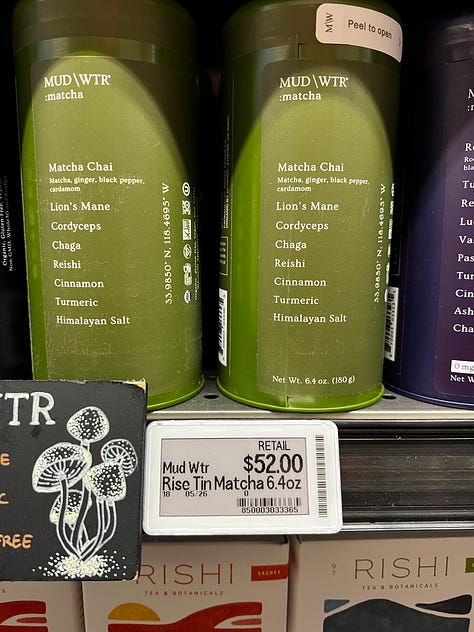

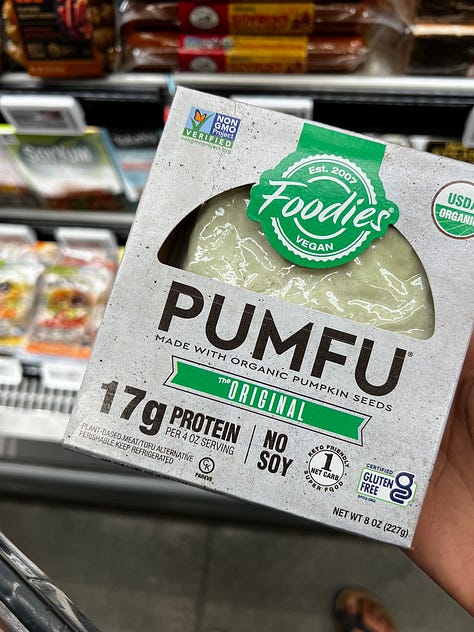

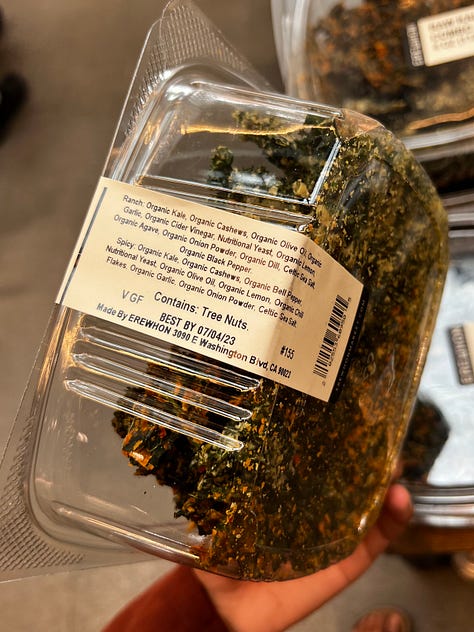



I bought a few things on sale: mushroom coffee, cacao juice, and a single can of sparkling water (with CBD! I was curious). As I walked to the bus stop, I realized I would feel weird about boarding my humble mode of transportation with an Erewhon bag so I stashed everything in my tote.
mini spice rack
eating
I made vegan kheer in a jar for some of my professors and mentors! And I’ve tried some exciting restaurants in LA recently, so an upcoming newsletter may be dedicated to that.
drinking
The aforementioned fizzy drinks I got from Erewhon.
reading
The Reading List by Sarah Nisha Adams. It’s cute!
listening
This chaotic and very poppy playlist, The Stephen Satterfield Show, and Popcast.




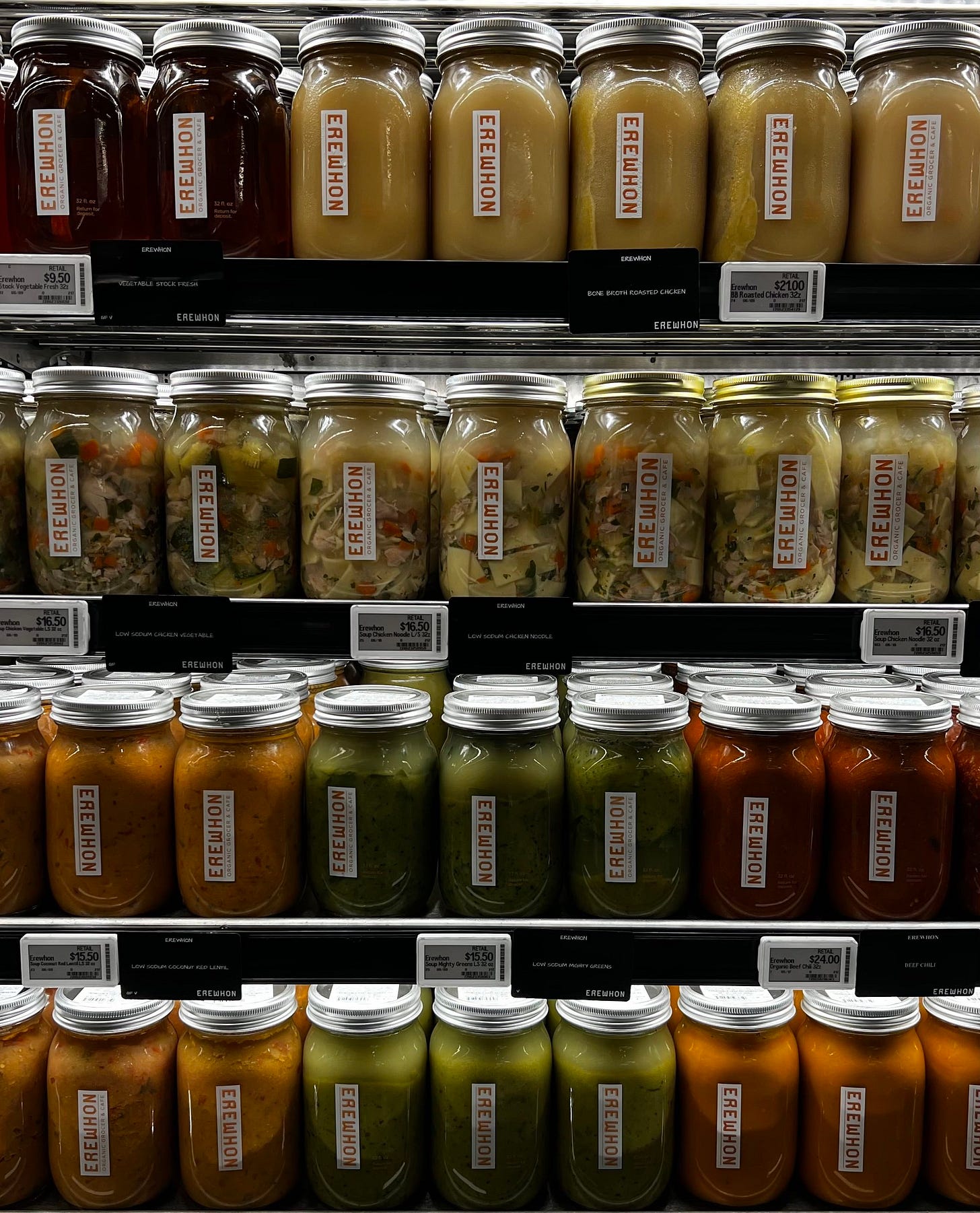
Didn’t know some of the history thanks for sharing! Definitely agree that it feels like a museum.
Thoroughly enjoyed this perspective!!